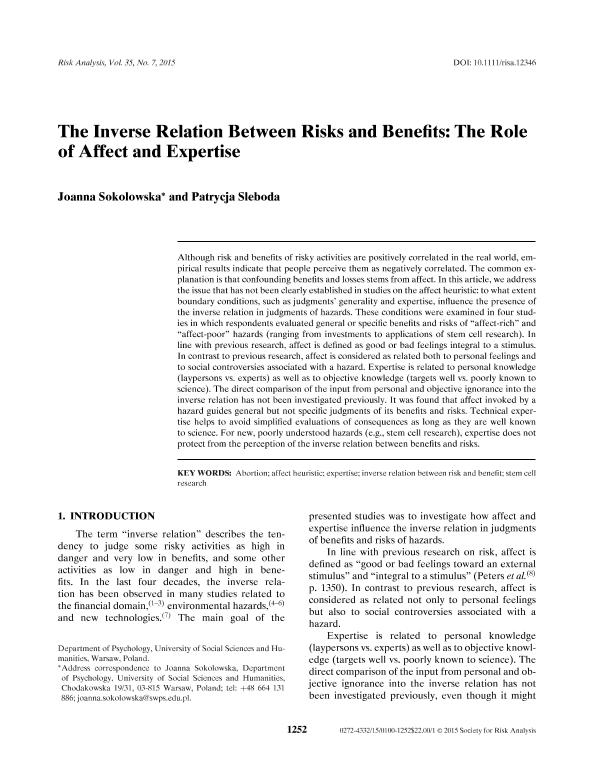The Inverse relation between risks and benefits : the role of affect and expertise

Contenido multimedia no disponible por derechos de autor o por acceso restringido. Contacte con la institución para más información.
| Tag | 1 | 2 | Valor |
|---|---|---|---|
| LDR | 00000cab a2200000 4500 | ||
| 001 | MAP20150030016 | ||
| 003 | MAP | ||
| 005 | 20150930122935.0 | ||
| 008 | 150916e20150701esp|||p |0|||b|spa d | ||
| 040 | $aMAP$bspa$dMAP | ||
| 084 | $a7 | ||
| 100 | 1 | $0MAPA20150015020$aSokolowska, Joanna | |
| 245 | 1 | 4 | $aThe Inverse relation between risks and benefits$b: the role of affect and expertise$cJoanna Sokolowska, Patrycja Sleboda |
| 520 | $aAlthough risk and benefits of risky activities are positively correlated in the real world, empirical results indicate that people perceive them as negatively correlated. The common explanation is that confounding benefits and losses stems from affect. In this article, we address the issue that has not been clearly established in studies on the affect heuristic: to what extent boundary conditions, such as judgments¿ generality and expertise, influence the presence of the inverse relation in judgments of hazards. These conditions were examined in four studies in which respondents evaluated general or specific benefits and risks of affect-rich and affect-poor hazards (ranging from investments to applications of stem cell research). In line with previous research, affect is defined as good or bad feelings integral to a stimulus. In contrast to previous research, affect is considered as related both to personal feelings and to social controversies associated with a hazard. Expertise is related to personal knowledge (laypersons vs. experts) as well as to objective knowledge (targets well vs. poorly known to science). The direct comparison of the input from personal and objective ignorance into the inverse relation has not been investigated previously. It was found that affect invoked by a hazard guides general but not specific judgments of its benefits and risks. Technical expertise helps to avoid simplified evaluations of consequences as long as they are well known to science. For new, poorly understood hazards (e.g., stem cell research), expertise does not protect from the perception of the inverse relation between benefits and risks. | ||
| 650 | 4 | $0MAPA20080545260$aRiesgos | |
| 650 | 4 | $0MAPA20080553357$aBeneficios | |
| 650 | 4 | $0MAPA20080591182$aGerencia de riesgos | |
| 650 | 4 | $0MAPA20080615130$aRelación costo-beneficio | |
| 700 | 1 | $0MAPA20150015778$aSleboda, Patrycja | |
| 773 | 0 | $wMAP20077000345$tRisk analysis : an international journal$dMcLean, Virginia : Society for Risk Analysis, 1987-2015$x0272-4332$g01/07/2015 Volumen 35 Número 7 - julio 2015 , p. 1252-1267 |

